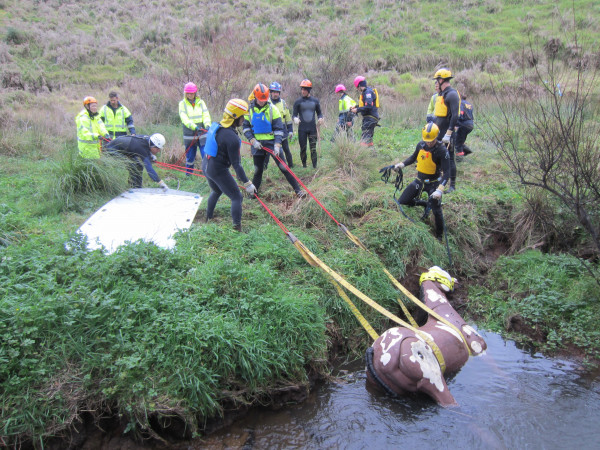Growing spotlight on large animal rescue
24 March 2022
A small group of dedicated people has been working hard to create practical and effective ways to improve how we respond to large animal rescue.
We respond to around 60 large animal rescue calls per year, most of which are horses and cattle generally trapped in mud, creeks, ditches, swamps, etc, but these also include traffic-related incidents, where animals are trapped in vehicles and horse floats.
Colin Russell, Group Manager Canterbury District, studied large animal rescue at Massey University, following that up with a scholarship trip to the UK.
"As primary responders, we bring the leadership capability to coordinate a team response with animal owners, vets and other partners. We have some knowledge in our brigades, but our big need is to coordinate and formalise our policies, procedures and training so we conduct safe, effective rescues," said Colin.
Ali Turner, Station Officer Waitemata District, also underwent training at Massey. Afterwards he engineered and developed specialist rescue equipment for purpose-built Large Animal Rescue kits. These kits are located at Silverdale, Kumeū and Papakura, and a replicated kit at New Plymouth.
"Animals have immense power and size, so we developed a kit to effect a rescue safely, minimise risk to our personnel and prevent harm to the animal," said Ali.
All this hard work will be given a further boost by the Australasian National Council for Emergency Services' (AFAC) ongoing development of a guideline for Large Animal Rescue Operations (LARO), adding weight to the development of our own policies and training.
Late last year, the AFAC Urban Operations Group established a working group to develop a guideline for LARO. Rob McDowall, Senior Technical Rescue Specialist in our Specialist Response Team, was nominated to represent Fire and Emergency on the group, as it was agreed that LARO would sit within that team.
Rob says the intention of the guideline is to provide an overview of rescue operations involving large animals, including scope, procedures, techniques, training and equipment, for AFAC partner agencies.
"A draft document was introduced to the working group, based on work done by the British Animal Rescue and Trauma Association (BARTA) for the National Fire Chiefs Council's National Operating Guidelines. Subject matter experts from within and external to Fire and Emergency have been involved in consultation and provided feedback from a New Zealand perspective, with almost all of this feedback being accepted by the working group.
"Once the working group has completed the draft guideline, it will go to the AFAC Rescue Technical Group for review, prior to going before the AFAC Urban Operations Group for approval. If approved, the guideline will then be tabled at the April meeting of the AFAC Council for sign-off and endorsement.
The guideline will sit within AFAC doctrine, and as such is an advisable course of action for AFAC member agencies. As a member, it gives us a framework from which we can review what we already do, and further develop our capability."




